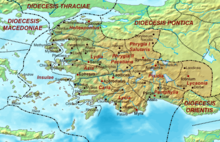
Satala (Ancient Greek: Σάταλα) or Satala in Lydia was a Roman era city[1][2] and Bishopric[3] in ancient Lydia.
Location[edit]
Its site is located near Adala in Asiatic Turkey.[4][5]
Pagan Religion[edit]
The city worshiped the typical mother and son pantheon found throughout Anatolia, and although a temple was built it did not mint coint as the town was only a village. It was part of a decapolis called the Katakekaumene, and May have been its religious center.
Bishopric[edit]
The city was also a see in the province of Lydia, and remains a vacant and titular see to this day.[6] It is in the province of Sardis.
Known Bishops
- Andrew[7](Council of Chalcedon)
- Elpidius of Satala banished after the Council of Constantinople[8][9]
- Giuliano signed in 458 the letter of the bishops of Lydia to ' Emperor Leo I after the death of Proterius of Alexandria.
- Michael attended the Second Council of Nicaea (787) .
- Philip took part in the Council of Constantinople (879)
Today Satala Lidia survives as titular bishop of the Roman Catholic Church but the seat is vacant since 22 October 1819 .
- Catholic Titular Bishop Nikodem Puzyna September 26, 1814 October 22, 1819.[10][11][12]
See also[edit]
References[edit]
- ^ W. M. Ramsay, The Historical Geography of Asia Minor.(Cambridge University Press, 2010) p131.
- ^ Joseph Bingham, The Antiquities of the Christian Church, 2 Volumes (1848)p400.
- ^ Satala at Catholic heirachy.org.
- ^ Richard Talbert, ed. (2000). Barrington Atlas of the Greek and Roman World. Princeton University Press. p. 56, and directory notes accompanying. ISBN 978-0-691-03169-9.
- ^ Lund University. Digital Atlas of the Roman Empire.
- ^ "Satala in Lydia (Titular See) [Catholic-Hierarchy]".
- ^ Richard Price, Michael Gaddis, The Acts of the Council of Chalcedon, Volume 1 (Liverpool University Press, 2005) p91.
- ^ Philostorgius, in Photius, Epitome of the Ecclesiastical History of Philostorgius, book 5, chapter 1.
- ^ Socrates of Constantinople, Church History, book 2, chapter 42.
- ^ Beschreibung auf catholic-hierarchy.org (englisch)
- ^ "Apostolische Nachfolge – Titularsitze". Archived from the original on 2019-01-19. Retrieved 2016-10-07.
- ^ Eintrag auf gcatholic.org
38°34′43″N 28°16′09″E / 38.57855°N 28.2693°E
Well, that’s interesting to know that Psilotum nudum are known as whisk ferns. Psilotum nudum is the commoner species of the two. While the P. flaccidum is a rare species and is found in the tropical islands. Both the species are usually epiphytic in habit and grow upon tree ferns. These species may also be terrestrial and grow in humus or in the crevices of the rocks.
View the detailed Guide of Psilotum nudum: Detailed Study Of Psilotum Nudum (Whisk Fern), Classification, Anatomy, Reproduction